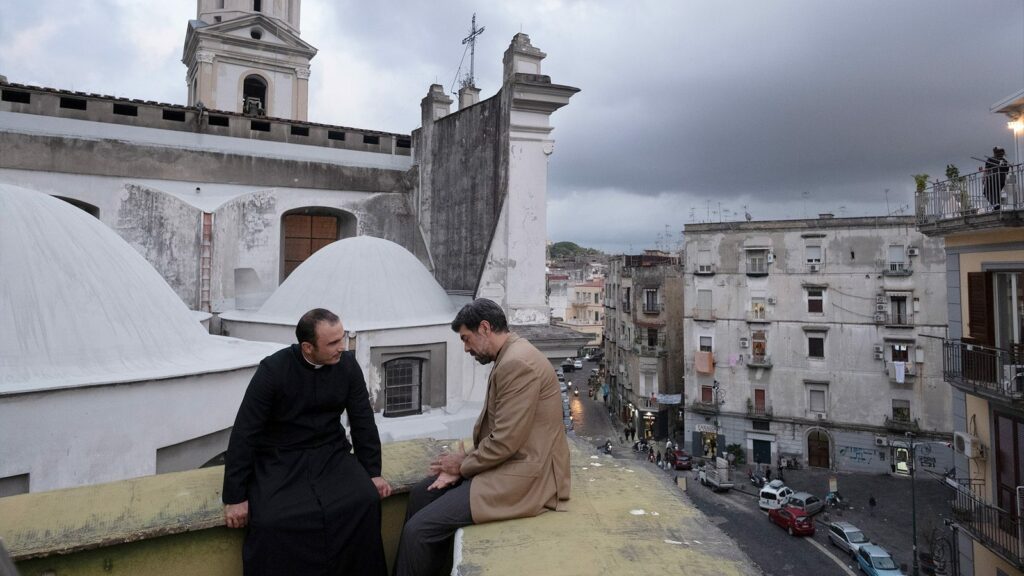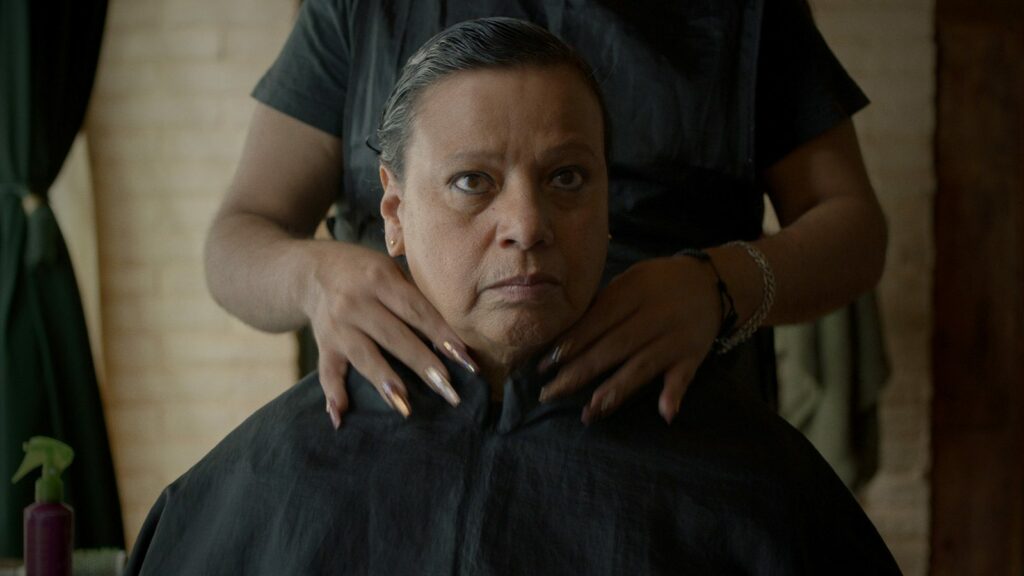Nostalgia (the title comes from a Pasolini quote about knowledge being found within nostalgia) takes us to the La Sanita neighbourhood of Naples, with the story of Felice, who grew up there, returning from Cairo after 40 years of exile, to check on his mother.
…….The first half of the film has us follow Felice around as he re-familiarizes himself with his old surroundings and gives us an interesting tour of a less familiar part of Naples and its people. Gradually, Felice’s past emerges (presented in small screen flashbacks) including the reason for his exile.
…….In the background of Felice’s visit are the Camora (the Naples mafia) who, led by the menacing, yet beatific Orestes, rule the neighbourhood and his adversary, the forceful local priest, Don Luigi who is determined to protect his flock from the evils of gangster-ism.
……..It takes a long time for the main plot to get going by the second half of the film. Even then, the plot develops in fits and starts, providing tension but in danger of becoming frustrating for the viewer. At the same time, we struggle to identify with the main character, Felice himself: his story can seem more like a device than that of a flesh and blood human.
……..The director seems intent on shifting the focus away from the plot and more on the neighbourhood and its residents, which is where the strength of the film lies, forsaking the usual plot mechanisms found in films set in Naples, so the film becomes about the city and the main characters are the background. The cinematography, with its muted colours and soft but deep shadows, adds to the mystery surrounding Felice and his past but also makes Naples a delight to experience and becomes the main attraction of the film.
“Dos.estaciones”
Review by John Le Blanc
Sundance Film Festival 2022
| Winner World Cinema Dramatic Special Jury Award | Acting Teresa Sánchez |
Dos Estaciones (Two Seasons) is set in rural Mexico’s Jalisco highlands at a small, independent tequila factory, owned and run by Maria, who has successfully developed the business started by her father. However, as the film’s title suggests, and as with any agricultural business, difficulties arise. Multi-national corporations begun to buy out the locals, a disease plaguing the agave plants that are the source of the tequila has resurfaced and Maria is carrying a lot of debt, due to her aggressive expansion of her operation, as pointed out to her by Rafaela, the young woman she has recently hired to manage her books.
……..The film begins as if it were a documentary, objectively and silently observing Maria amidst her tequila operation, both in the fields and at her factory. Gradually, we move inside Maria’s personality but not too deeply, as the motivations for her behaviours are never explained, suggesting that human beings, like the seasons, have a duality that cannot be easily resolved. Another example of this duality lies in the contrast between the strongly masculine Maria and her more feminine friend Tatin, the owner of a beauty salon (whom Maria has helped financially, but with Tatin now becoming more independent).
…….Such twoness is effectively symbolized in the traditional Mexican spinning fireworks wheels and the doughnuts Maria performs in her new truck. The film successfully allows us to wander among the people and inhabit the locale, employing powerful cinematography (vividly contrasting day and night shots) while maintaining the film’s documentary feel as it patiently unfolds universal truths about human existence we can all relate to. Like many of the best films, Dos Estaciones encourages us to feel what we are seeing instead of merely understand it.
“Carajita”
Review by John Le Blanc
San Sebastián International Film Festival 2021
| Winner New Directors Award | Ulises Porra Silvina Schnicer |
Feature films from the Caribbean are a too rare occurrence, so it is welcome to have this new one, set in the Dominican Republic.
……..Although the central situation of the story is, unfortunately, very similar to that in one of Argentinian director Lucretia Martel’s movies, this film stands on its own, due to its unique vision. Also, the film covers familiar territory for films from Europe’s colonies: the relationship between the white colonizers and the Black colonized, depicted within a white family / black servant situation.
……..Yet, here again, this new film offers a fresh perspective on that situation, as the close relationship between European white teenager Sara (the “carajita” / “little bitch” of the title) and local black woman Yarisa, the family’s maid goes into crisis. The film captures the psychological depths of the characters’ dilemmas through fleeting, impressionistic images, idiosyncratic camera work and strong, open-ended symbolism, all of which are kept from becoming heavy-handed. In addition, the island landscape is given symbolic power while avoiding clichés about the tropics. ……Neither is the portrayal of the characters stereotypical: although the European family are decadent and it is vaguely suggested that the father may be involved in corruption, they are presented as human beings, although criticism of their attitudes and actions is not blunted. Similarly, the culture and behaviours of Yarisa and her family are also presented sensitively. When the images tell much of the story, the audience has to work harder, but in this case, the work is refreshing and rewarding.












